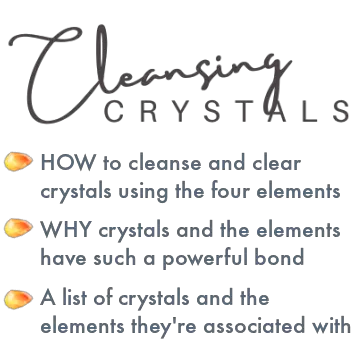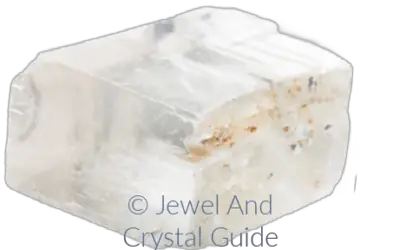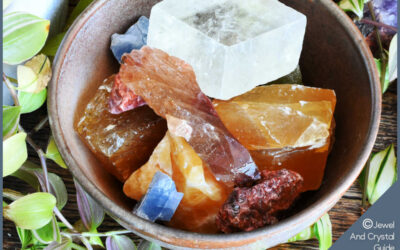You’re probably here because you’re wondering if a crystal you have is real rose quartz or a fake. Most fake quartzes are made from glass, so below you’ll find 16 ways to tell the difference between real rose quartz and factory-made glass quartz.
By the end of this post, you’ll know 16 things you can do to test if a crystal is real rose quartz or an imitation.
Real rose quartz…
Has a specific gravity of 2.65
A fairly accurate and reliable way to tell if rose quartz is real is to measure its specific gravity. To calculate this, we measure how much “space” the crystal takes when we drop it in water.
The specific gravity or relative density of rose quartz is 2.651, which can be measured using a digital scale that shows at least two decimals.
Here are the steps to calculate the specific gravity of a rose quartz crystal:
- Weigh the container you’ll be using for this measurement, writing down the weight to two decimal places. Make sure the container is large enough to hold some water and the crystal you are testing. This is your first measurement.
- Add water to the container and weigh it again, again writing down the number to two decimal places. This is your second measurement.
- Add the crystal to the water, and write down the weight to two decimal places. This is your third measurement.
- Subtract the weight of the empty container (first measurement) from the weight of the water-filled container (second measurement) and the water and crystal weight (third measurement). You now have the true weights of the water and the water and crystal. So these are the weights without the container.
- Divide the true weight of the crystal and water weight by the true weight of the water-only weight. This gives you the crystal’s specific gravity or relative density.
- If the specific gravity is 2.65, then you have a real rose quartz in your hands. If the specific gravity reading is 2.5, it’s a fake glass crystal.
Weighs more than glass
Closely related to specific gravity above, real rose quartz is heavier than glass (which is why its specific gravity or relative density is higher than glass).
In plain English, real rose quartz has a solid heavy feel to it and weighs more than glass, especially when comparing large crystals.
If you hold two crystals of similar size in your hands or put them on a digital scale, a fake crystal will weigh less or feel lighter than a real crystal because the fake is probably made of glass.
Has different shades of pink in it
There are many different colored quartzes, and the name tells you what color the quartz is. For example, clear quartz has no color in it and citrine tells us that it’s yellow quartz.
Rose quartz is always pink. It comes in different shades of pink – from light (almost white) to a medium blushing pink. If it isn’t pink, then it isn’t rose quartz. But if it is pink, it might still be a fake.
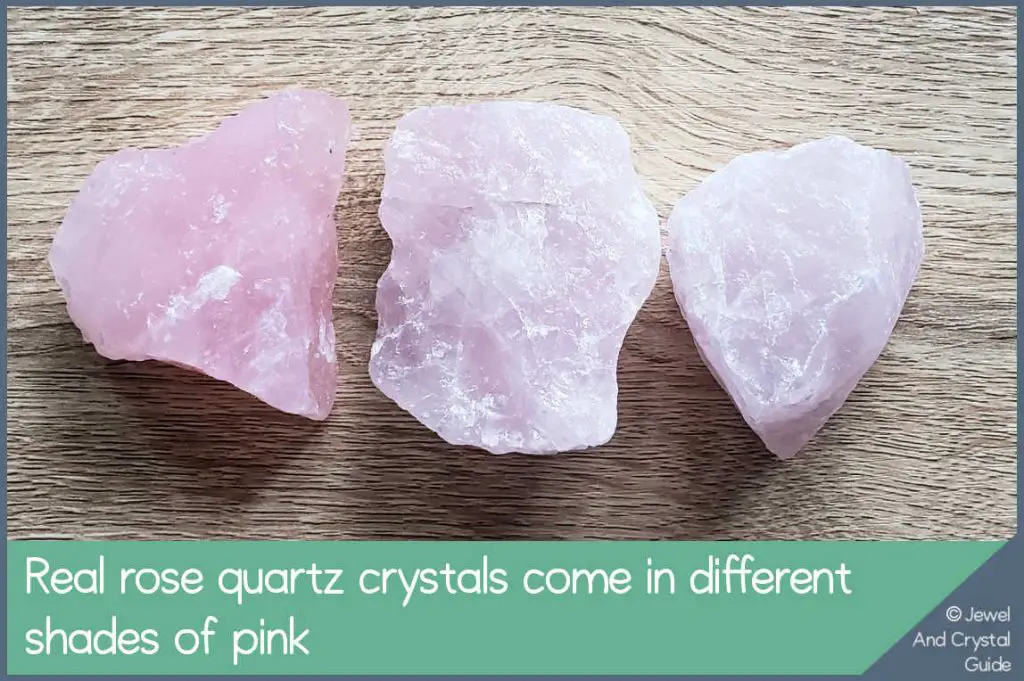
If you look closely at a real piece of rose quartz, you’ll notice lines running through it. And if you look closer still, you’ll notice that there are variations in the pink by these lines:
- The colors tend to be light pink on one side of a line and darker on the other side
- The crystal is also often lighter, or snow white, around its edges, especially when it’s raw.
Sometimes the color variations are very noticeable and sometimes not, but if you inspect the entire crystal, you should see this natural pattern emerge.
If you hold several pieces of rose quartz next to each other, especially if you got them at different times or from different places, then you’ll notice that the shades of pink also vary, with some pieces being darker pink than others.
The bigger the piece, the easier it is to notice the colors within. If you’re looking at a very small piece of rose quartz, you might struggle to see the color variations and you could use a magnifying glass for a better view.
Real rose quartz is never solid pink throughout, unless perhaps it’s a very small piece that was taken from one color area of a bigger piece. But I’ve checked my own collection and even the small pieces of rose quartz have slightly different pinks in each piece.
If the pink is the same throughout your crystal, or it’s a purple or bright pink color, it’s probably glass that’s been dyed in a factory to make it look like rose quartz.
If you think it may be dyed glass, look closely at cracks in the crystal. If the color is darker or more distinct along the cracks, it’s almost certainly dye that collected in these cracks.
Fades in sunlight
Over time, real rose quartz fades or changes color if it’s left to stand in strong sunlight for long enough, though it’s perfectly safe to use sunlight to cleanse and charge the crystal if you follow these simple instructions.
Fake rose quartz, made from glass, does not usually lose its color when left outside, unless it’s left out in the sun permanently for several years.
Has random patterns inside
Quartz naturally has lighter and darker areas inside it, which you can see clearly when you hold it up to the light. These light and dark areas are always irregular, so they are all shapes and sizes in the quartz.
A real rose quartz never has perfectly balanced or clear shapes in it, such as perfectly round bubbles or patterns.
If a crystal has perfect pink and white shapes or an obvious pattern in it, then it’s most likely a fake. If there are visible bubbles or hollow spots inside, the crystal is most likely glass that got air bubbles in it during the manufacturing process.
And if you look at several rose quartz crystals from the same seller, the pattern of pinks in the crystals should all look different. If some patterns look exactly same, like carbon copies of each other, then all the crystals are probably fake.
Is not see-through
This is not a foolproof method to tell if a rose quartz crystal is real or not, but it might help you on your journey of discovery. I experimented with my own rose quartz collection and this is what I found:
Real rose quartz isn’t see-through when it’s quite thick, such as a smooth tumbled palm stone or a rough raw crystal. But small pieces or thin pieces of real rose quartz are see-through, and work much the same way as glass crystals.
To test if a crystal is see-through, put it on a piece of paper that has a picture or words printed on it. This could be a page from a magazine or anything printed on your home printer.
If you put real rose quartz on the paper with print, you won’t see any of the print that’s under the crystal. But when I tried this with small shards of real quartz, I could see the dark colors of the print and I could even make out large letters.
If you can clearly see a distorted version of the picture or printed words on the paper under the crystal, then the piece is see-through and is most likely glass that’s magnifying the print. It’s a fake.
Shows white swirls
Rose quartz is pink with white whirls inside. All real rose quartz has these swirls in it from fractures that healed when the crystal was created.
The bigger a piece of rose quartz, the easier it is to see the white swirls in it.
If you look at a piece of rose quartz under a microscope at 10x magnification, the swirls in real quartz can appear white or transparent. In fake quartz, these swirls might be non-existent, look brown, or look unnatural with a clear pattern that was created by man.
Never has a raised mold line on its surface
Real tumbled rose quartz crystal is perfectly smooth, without any markings or raised lines on it. Real raw rose quartz has an irregular and rougher surface, but never any straight lines on it.
Fake rose quartz crystal that’s made from glass sometimes has a raised line or visible marking on it from the mold that was used to make it.
If you want to know what sort of line to look for, feel a glass mug. You should find a raised line running vertically, from top to bottom, along one side of the cup, usually by the handle. This line is from the mold that shaped the glass into a mug.
Can be tumbled
Real rose quartz can be tumbled into a smooth, smaller crystal, but fake glass quartz shatters when it’s tumbled.
If you have a piece of quartz and you’re wondering if it’s real, try tumbling it yourself if you aren’t worried about destroying it.
Tumbling is done by putting a crystal into a machine, such as this hobby tumbler from Amazon, that rolls the crystal around with rough rocks. As the rocks and crystal roll around together, the rocks remove the crystal’s rough edges, making it smooth.
If your crystal survives tumbling, it’s real. If your crystal breaks into pieces or shatters when tumbled, it’s a fake.
As a general rule of thumb, most raw rose quartz is real. Most fakes are sold in jewelry as tumbled crystal that’s smooth and shiny because glass, which is what most fake rose quartz is made of, is also smooth and shiny.
Cannot be scratched with steel
The Mohs scale measures how hard minerals are. This scale runs from 1 to 10, with 1 being the softest (talc) and 10 being the hardest (diamonds).
Items on the Mohs scale are ranked above all the things that are softer than them and below all the things that are harder than them.
Real rose quartz is a 7 on the Mohs scale, which makes it softer than the minerals: topaz, corundum, and diamonds. Any of these minerals can scratch a rose quartz, but they would also scratch a fake rose quartz made from glass because they’re harder than glass too.
The trick to telling a real rose quartz from a fake is to try to scratch the crystal with a steel nail or a steel knife. If the steel leaves a mark, the crystal is probably a fake. If the steel leaves no mark, it’s probably real rose quartz.
This is because steel is softer than quartz but harder than glass on the Mohs scale.
Can scratch steel
According to the Mohs scale, real rose quartz is harder than steel.
To test if a rose quartz crystal is real, scratch something made from steel, such as a steel knife, a watch casing, or even a steel file.
If the crystal leaves scratch marks, even tiny ones, then it’s real quartz. You might need to look for scratches through a magnifying glass to see them properly.
Feels cooler than glass
Real rose quartz is usually cooler than fake rose quartz made from glass.
To test this out, keep a drinking glass in the same area as a real rose quartz so they both come to room temperature. Then place each one on your bottom lip, to see if you can feel a slight difference in temperature.
If the crystal is fake, it will feel like it’s the same temperature as the drinking glass on your lips because both are made from glass. If the crystal is real, it should feel a little cooler than the drinking glass.
If you can’t feel any difference and you want to be sure, use an infrared thermometer, like this one from Amazon, to measure the surface temperature of each. A regular thermometer won’t work.
Is about the same price, no matter where you buy it
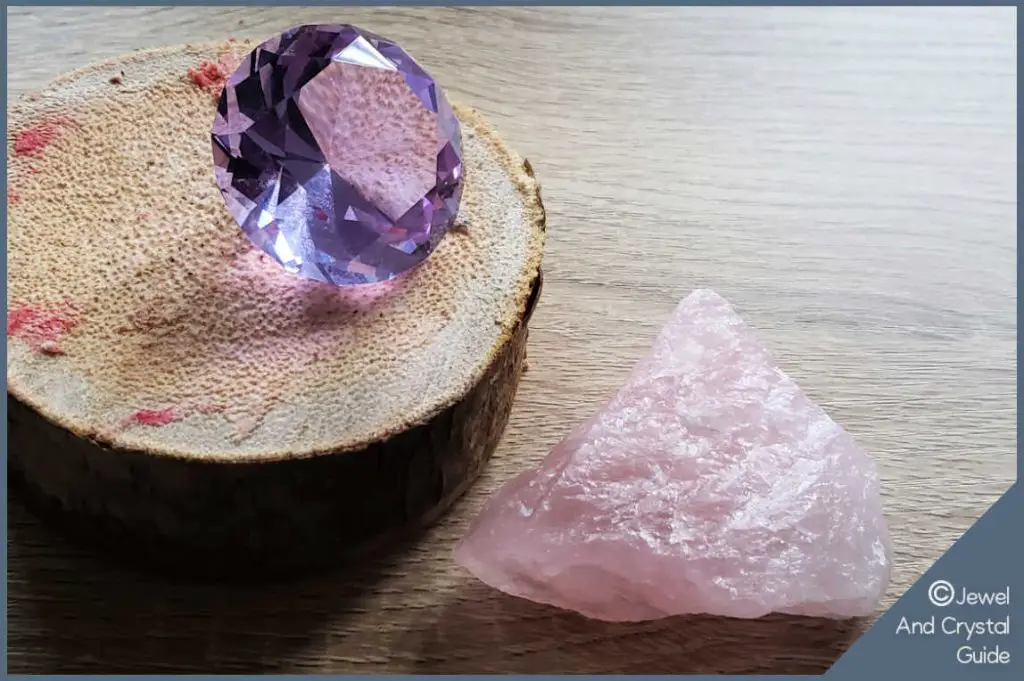
Crystal sellers buy crystals from suppliers. There are a limited number of rose quartz suppliers, and their prices are all very similar. So all crystal sellers are paying about the same price for rose quartz.
Sellers have to sell these crystals for more than what they paid for them, if they want to make a profit. So you’ll find that crystal sellers generally sell rose quartz for about the same price – their supplier’s price plus a markup for profit.
If you find rose quartz that’s on sale for a price that’s too good to be true (much, much cheaper than other sellers), there’s a chance it’s fake.
Exceptions might be for online stores that have less costs to cover than brick-and-mortar stores, and stores that are closing down and trying to get rid of stock.
Is called rose quartz by the seller
Real rose quartz should be called “rose quartz” by the seller, and nothing else.
But some sellers try to sell more crystals or fakes by giving regular rose quartz exotic and unusual names, to make the crystals sound more exciting and make you want to buy them.
If a crystal looks like a rose quartz but it’s being sold with an unusual, catchy name, or a name you’ve never heard of before, it’s probably a marketing trick to get you to pay more for regular rose quartz or it’s a fake.
Do some research or ask a professional to see if the name is for a real crystal. For example, many people question if pink amethyst is real or if it’s just rose quartz “pretending” to be amethyst (click here to find out).
Comes from a trustworthy seller
If you buy rose quartz from a seller that you know you can trust, and that seller tells you the quartz is real, then it probably is.
Below are some things you can do to make sure the rose quartz is real:
- Do some online research about the seller, to look for bad reviews or complaints that other people might have made. You can also speak to others or join Facebook groups and ask for recommendations.
- Check the seller’s website to see what information they give and if they look authentic.
- Ask the seller to provide proof of where they got the rose quartz from. Most rose quartz comes from Brazil, but it’s also mined in India, Madagascar, Sri Lanka, Sweden, Namibia, and California.
- Buy rose quartz jewelry that is certified by the Gemological Institute of America (GIA) or the gem certification body in your country.
Can be confirmed by a professional
If you really need to know if a crystal is real rose quartz or not, and none of the above methods have given you a definitive answer, then ask a professional crystal dealer, lapidist, or appraiser to take a look at the crystal.
A professional will have the tools, knowledge, and experience to confirm if a rose quartz crystal is real or not. However, rose quartz is fairly common and is not a very expensive crystal, so it is not really worth making fake stones to sell and fake rose quartz is not a widespread problem.
As a general rule of thumb, your crystal is more likely to be real than fake.






